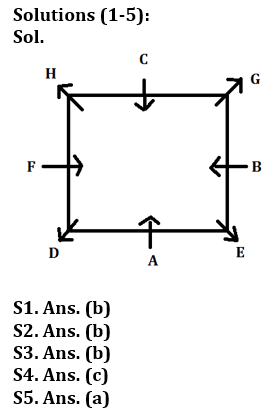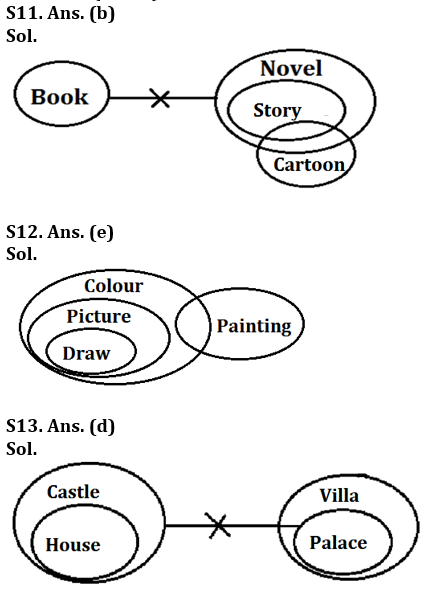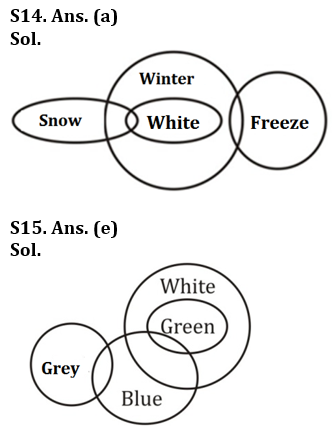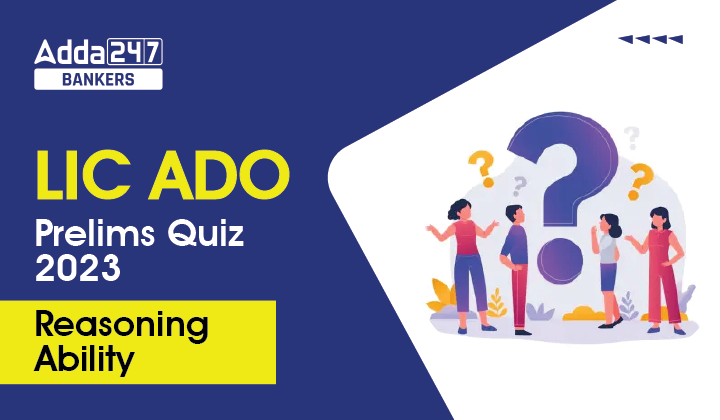Directions (1-5): Study the information carefully and answer the questions given below.
Eight persons are sitting around a square table such that four of them sit at the corners and rest on the middle of the side. The persons sitting on the corners face opposite direction to that of the ones sitting on the middle of the side. The one sitting immediate left to D does not face outside. E and B are immediate left to each other. C faces A. F and D are immediate neighbors of each other. The one sitting 5th right to the one who is 3rd left to A does not sit at the corner. G sits 3rd right to A. H sits opposite to E.
Q1. What is the position of C with respect to D?
(a) 3rd to the left
(b) 3rd to the right
(c) 4th to the left
(d) 5th to the right
(e) none of these
Q2. How many persons are sitting between A and F when counted form the right of F?
(a) Two
(b) One
(c) Three
(d) Four
(e) None of these
Q3. Who among the following sits opposite to B?
(a) E
(b) F
(c) C
(d) A
(e) none of these
Q4. What is the position of H with respect to E?
(a) 3rd to the left
(b) 3rd to the right
(c) 4th to the left
(d) 5th to the right
(e) none of these
Q5. Four of following form a group find the one who does not belong to that group?
(a) E
(b) F
(c) C
(d) B
(e) A
Direction (6-10): In these questions, relationship between different elements is show in the statements. The statements are followed by conclusions. Study the conclusions based on the given statements and select the appropriate answer:
(a) If only conclusion I follows.
(b) If only conclusion II follows.
(c) If either conclusion I or II follows.
(d) If neither conclusion I nor II follows.
(e) If both conclusions I and II follow.
Q6. Statements: F > R ≥ T = E > W ≤ Q
Conclusions: I. E < F II. Q ≥ T
Q7. Statements: W = G ≥ H ≥ T = C ≤ V ≤ B
Conclusions: I. T < G II. C = G
Q8. Statements: K > I ≥ G > F ≤ T < R
Conclusions: I. K > T II. R > F
Q9. Statements: Q > O ≥ P = K; O < U ≤ Z
Conclusions: I. Z > K II. Q > U
Q10. Statements: K < G ≤ D < C > R ≤ Y
Conclusions: I. C > G II. K < D
Directions (11-15): In each of the questions below, some statements are given followed by some conclusions. You have to assume all the statements to be true even if they seem to be at variance from the commonly known facts and then decide which of the given conclusion logically follows from the information given in the statements.
(a) If only conclusion I follows
(b) If only conclusion II follows
(c) If either I or II follows
(d) If neither I nor II follows
(e) If both I and II follow
Q11. Statements: No book is novel
All story is novel
Some cartoon is story
Conclusions: I. Some cartoon is not book is a possibility
II. All book are cartoon is a possibility
Q12. Statements: All picture is colour
All Draw is picture
Some painting is colour
Conclusions: I. Some colour are draw
II. All painting are picture is a possibility
Q13. Statements: All house is castle
All palace is villa
No castle is palace
Conclusions: I. No villa is house
II. Some palace are castle
Q14. Statements: All white are winter
Some snow is white
Some winter are freeze
Conclusions: I. All snow being freeze is a possibility
II. Some white are definitely not freeze.
Q15. Statements: Some blue are green
Some grey is blue
All green are white
Conclusions: I. Some grey is neither blue nor white is a possibility
II. All green are grey is a possibility
Solutions

Solutions (6-10):
S6. Ans. (a)
Sol. I. E < F (True) II. Q ≥ T (False)
S7. Ans. (c)
Sol. I. T < G (False) II. C = G (False)
S8. Ans. (b)
Sol. I. K > T (False) II. R > F (True)
S9. Ans. (a)
Sol. I. Z > K (True) II. Q > U (False)
S10. Ans. (e)
Sol. I. C > G (True) II. K < D (True)







 GA Capsule for SBI Clerk Mains 2025, Dow...
GA Capsule for SBI Clerk Mains 2025, Dow...
 The Hindu Review October 2022: Download ...
The Hindu Review October 2022: Download ...
 ECGC PO Scorecard 2025 Out, Check Marks
ECGC PO Scorecard 2025 Out, Check Marks




